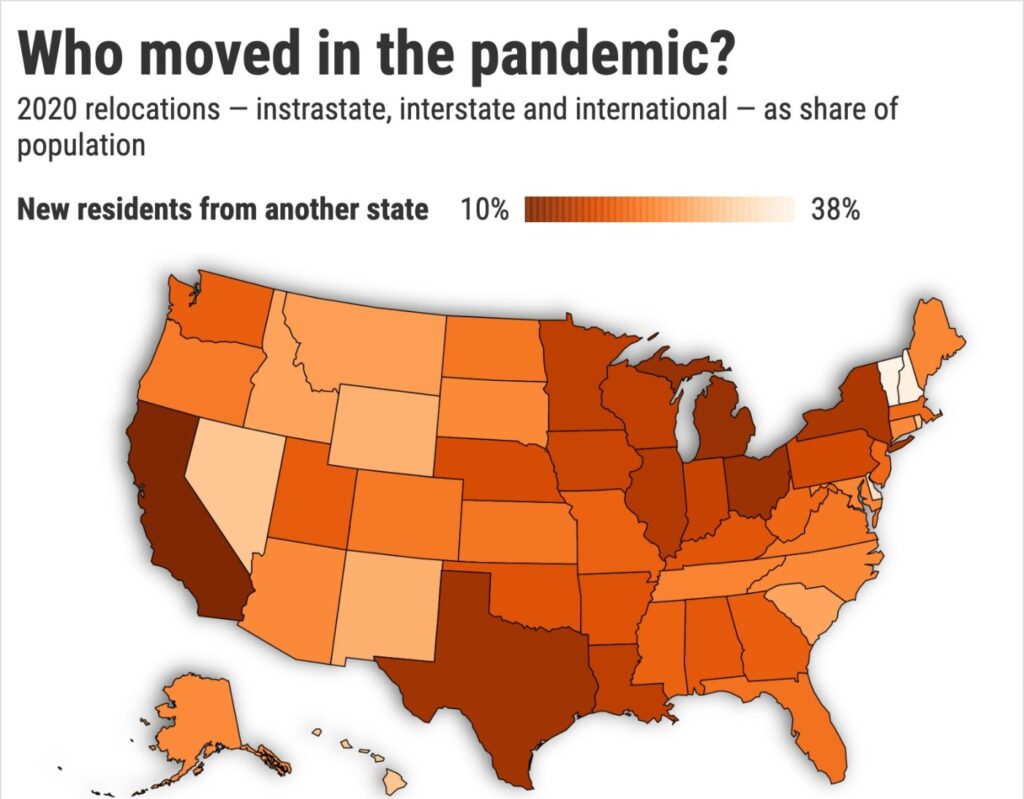
”Survey says” looks at various rankings and scorecards judging geographic locations, noting that these grades are best seen as a mix of art and data.
Buzz: Relatively few Americans move to California. The latest example shows us that just one in 10 of California’s new neighbors in pandemic-stricken 2020 were from another state — the lowest share in the nation.
Source: Coronavirus and a less-than-friendly White House made US Census work challenging in 2020. Interstate migration data was an unfortunate victim, so the grand “exodus” debate is muddled. The bureau has now released “experimental” data on where 2020 residents came from, so we can debate California’s stats as a population magnet — or not.
Details
So where do new neighbors come from?
As far a total numbers go, Californians were the most likely to have moved somewhere amid coronavirus craziness in 2020 — 4.3 million — followed by Texas at 4 million and Florida at 3 million. But when you consider California’s population, the largest in the U.S., that mobility represents just 11% of all residents — or the ninth-lowest share among the states.
DC was highest with 19.4% of its residents moving in 2020, then Idaho at 16.2%, Wyoming at 16.1%. Fewest moves? New York at 9.6% and New Jersey at 10.1% — both hard-hit in the pandemic’s early days.
And California’s economic rivals? Texas was No. 14 at 13.8%. Florida was No. 11 at 14.1%.
But let me try to explain my thesis that California’s unpopular with fellow Americans with my trusty spreadsheet’s analysis of the previous hometowns of these new neighbors.
Let’s start with the notion that Californians like California. Your new neighbor most likely was a Californian.
Intrastate moves represented 84.6% of those 4.3 million California relocations in 2020, the third-highest share after Ohio at 85.3% and Michigan at 85%. Fewest? DC at 52.9%, then Vermont at 59.3%, and New Hampshire at 61.4%. Texas was fourth-highest at 83%, Florida was No. 32 at 73.2%.
And foreigners like California, too. Note that 5.2% of relocations to California were from foreign lands, that’s ninth-highest among the states.
Tops with international relocations? Hawaii at 7.8%, then Rhode Island at 6.1%, and DC and New York at 5.9%. Smallest? West Virginia at 1.5%, then Arkansas at 1.6% and Tennessee at 1.8%. And Texas? No. 15 at 4.1%. Florida? No. 6 at 5.4%.
California’s population-growth challenge stems with relocations from elsewhere in the U.S.
Yes, 437,275 did come to California, the third-largest inflow for 2020. Florida was No. 1 at 647,910, then came Texas at 518,727.
Related Articles
Billionaire vs. Newport Beach apartments an ‘abuse of CEQA,’ housing advocates say
HOA Homefront: When can a board amend CCRs and bylaws?
Auditor finds flaws in the state’s housing process
Freddie Mac ending automated appraisal waivers on cash-out refinances
In Palm Desert, a Moorish mansion with a hookah lounge gets $11.5M
But as a share of population, California ranked dead last at 10.1%. Yes, no state has a smaller share of relocation from elsewhere in the U.S. That’s a key reason why California’s population is now in decline.
Texas share of interstate inflow was low, too — No. 48 at 12.9%. And Florida was middling No. 26 at 21.4%.
The biggest interstate slice of new neighbors was DC at 41.2%, then Vermont at 37.1% and New Hampshire at 36.6%.
Bottom Line
Despite all the vacation allure of the Golden State, one of California’s big population growth challenge its unpopularity with other Americans as a place to live. How to fix that — or if this shortfall is a problem worth addressing — is a puzzle.
PS: Census reminds folks not to compare this “experimental” data to previously report migration stats. Caveat noted, the 437,275 who moved to California from other states in 2020 was 12% below the 2010-2019 average inflow from elsewhere in the U.S.
Jonathan Lansner is the business columnist for the Southern California News Group. He can be reached at jlansner@scng.com
